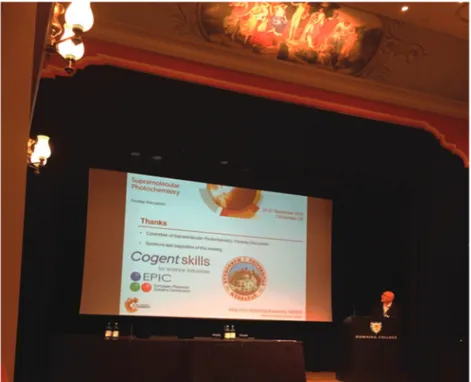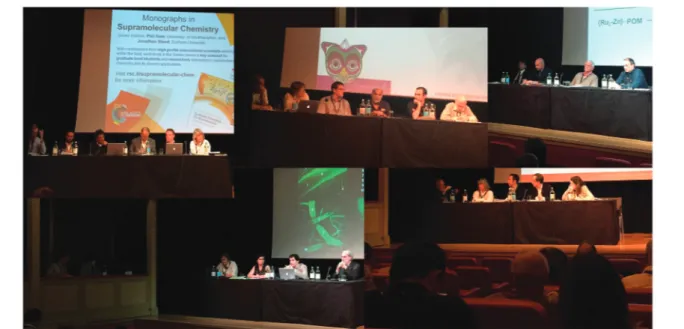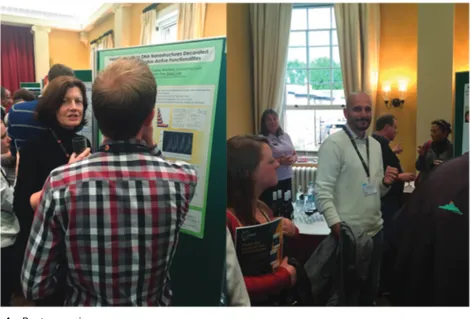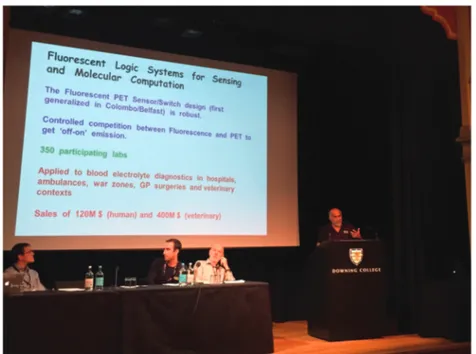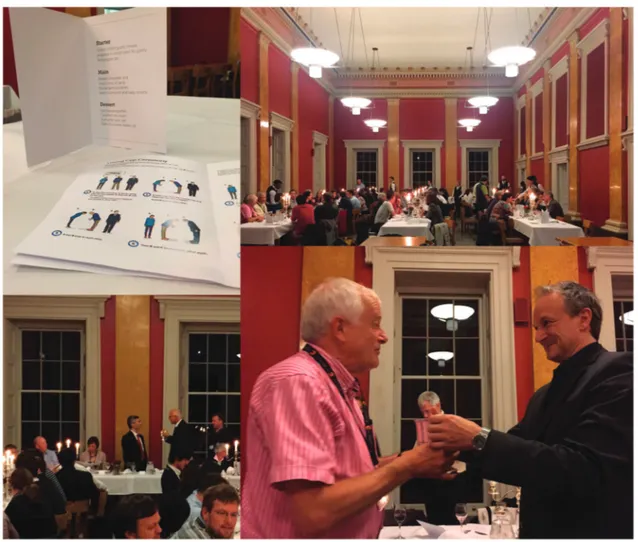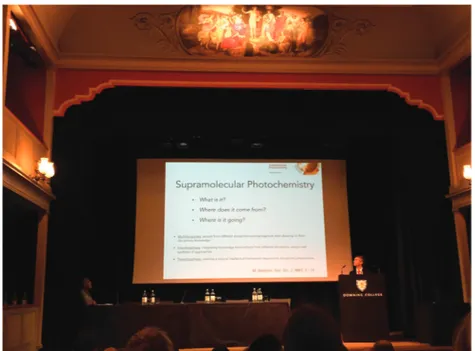Cite this: Chem. Commun., 2016, 52, 4410
Highlights from Faraday Discussion 185:
Supramolecular Photochemistry, Cambridge, 2015
E. M. Tuite*aand F. Puntoriero*bIn September 2015, Cambridge hosted the 185th Faraday Discussion meeting in the magnificent and historically rich surrounds of Downing College. The meeting brought together over 110 scien-tists from around the world to discuss the most recent advances in the wide field of supramolecular photochemistry; and also to define strategies for solving the problems of the future in this field of research.
The Faraday Division of the Royal Society of Chemistry have been organis-ing high impact Faraday Discussions for over 100 years. These Discussions are international conferences that focus not only on emerging fields in physical chemistry, but also on the interface of physical chemistry with other scientific disciplines. Faraday Discussions are not standard conferences. They have an engaging and unusual format where research articles written by the speakers, invited by the scientific organizing com-mittee, are distributed to the delegates before the meeting. The majority of the meeting is then devoted to discussion of the papers and all delegates, from experienced professors to new graduate students, have an opportunity to critically
contribute to the discussion. Before the first session, Tom Wilson and Sage Bowser (Royal Society of Chemistry Pub-lishing Editors) explained the format of the Discussion to the delegates, after which they busied themselves recording the proceedings for the final publication.1 The field of photochemistry, which is located at the intersection of chemistry, physics and biology, and at the interface between matter and light, is now more than ever accompanied by profound quali-tative changes. Modern advances in syn-thesis, instrumentation, and theory have opened new avenues of research, and have allowed reassessment and develop-ment of older systems. In recent decades, the interest of researchers has gradually shifted from processes that occur within active molecules (molecular photo-chemistry) to reactions that take place between molecular excited states and appropriate reaction partners (e.g., inter-molecular electron and energy transfer) in complex and hybrid systems. Since its inception in 1987,2the study of artificial assemblies of multiple molecular compo-nents capable of performing useful func-tions under light stimulus – the field of Supramolecular Photochemistry – has experienced impressive growth. It impacts on many topics, including artificial photosynthesis, light-activated molecular machines, molecular logic gates, and luminescence sensing and imaging, leading to applications in biomedicine, solar energy conversion, and molecular electronics
and informatics. The breadth of topics was reflected in the composition of parti-cipants who spent three days discussing the fundamentals, applications and pro-blems that distinguish or, perhaps con-nect, different aspects of supramolecular photochemistry.
The meeting officially kicked off on Monday, September 20, 2015, and began with the welcoming address from the conference chair Professor Sebastiano Campagna (University of Messina, Italy), who also headed the scientific commit-tee constituting Professor Alberto Credi (University of Bologna), Professor Luisa De Cola (University of Strasbourg), Professor Anthony Harriman (Newcastle University), Zoe Pikramenou (University of Birmingham) and Professor Antonin Vlcek, (Queen Mary, University of London).
Sebastiano Campagna (Fig. 1) presented the principal themes for discussion. Natural and artificial photosynthesis New information derived from the study of natural systems will be discussed and used to aid the design of artificial photo-synthetic systems. Attention will be given to both synthetic light-harvesting antennae and molecular devices capable of effica-cious charge-separation.
Light-activated molecular machines and logic gates
The study of multi-component systems where illumination induces controlled mechanical movements (machines) and/or aSchool of Chemistry, Bedson Building,
Newcastle University, Newcastle upon Tyne, NE1 7RU, UK. E-mail: [email protected]
bDip. Scienze Chimiche, Biologiche, Farmaceutiche ed
Ambientali, Universita` degli Studi di Messina, V.le F. Stagno d’Alcontres, 31, I-98166 Messina, Italy. E-mail: [email protected]
DOI: 10.1039/c6cc90103d
www.rsc.org/chemcomm
CONFERENCE REPORT
Published on 03 March 2016. Downloaded on 8/27/2020 1:02:18 PM.
View Article Online
where light can be exploited as input/output information. The relevance to protein folding should not be missed.
Self-organization of photo-active nanostructures
Identifying new and improved ways to assemble supramolecular entities with a photo-active unit, such as liquid crystals, organo-gels, dendrimers, etc. Although synthesis plays a crucial role in the devel-opment of such species, the discussion will deal with the synergistic features of the actual assembly.
Luminescence sensing and imaging The in situ detection of changes in the local topology and in the concentration of selected substrates, including biologically relevant species.
Opening lecture
The Discussion was introduced with a brilliant lecture by Devens Gust (Arizona State), who gave a general overview of the evolution of supramolecular photo-chemistry from the beginning to very recent and novel results. This also pro-vided a perspective on his outstanding
contributions to the field over the years, within the context of other developments in the field.
Professor Gust (Fig. 2) started with the question: what is supramolecular photo-chemistry? And during his talk he answered the question through selected examples. As a starting point, he took the
definition of supramolecular chemistry given by Jean-Marie Lehn in his Nobel lecture in 1987, and then moved to the description of a Supramolecular Photochemistry System given by Balzani
and co-workers as ‘‘an appropriate
assembly of suitable molecular compo-nents capable of performing light-induced functions’’.3,4
In his amazing talk, (DOI: 10.1039/ C5FD00142K) Professor Gust described how supramolecular photochemical devices consist of chromophores, donors and acceptors that are associated in such a way that the component moieties interact by mechanisms such as, but not limited to, singlet or triplet energy transfer, photo-induced electron transfer and exchange of spin information. By choosing the moieties and controlling their modes of interaction, the supramolecular photo-chemist can demonstrate scientifically interesting and potentially useful phenom-ena that are not possible in simpler systems. The association mechanisms include not only a variety of non-bonded interactions but also linkages through chemical bonds that are not part of the active components. The examples given dealt with artificial photosynthesis, molecular logic, and spin– spin interactions, thus providing an appro-priate overview of the principal themes of the Discussion.
Fig. 1 Welcoming talk by Professor Sebastiano Campagna.
Fig. 2 Opening lecture by Professor Devens Gust.
Session 1: natural and
artificial photosynthesis
The first session was chaired by Professor Antonin Vlcek and Professor Anthony Harriman, and began with a presentation by Gary Brudvig (Yale). The talk (DOI: 10.1039/C5FD00087D) dealt with the
mechanism of photosynthetic water
oxidation that occurs at the oxygen-evolving complex (OEC) of Photosystem II (PSII). The OEC, which contains a Mn4CaO5 inorganic cluster ligated by
oxides, waters and amino-acid residues, cycles through five redox intermediates known as Si states (i = 0–4). Professor
Brudvig presented a detailed analysis of the S-state dependent substrate water binding kinetics taking into considera-tion data from Mn coordinaconsidera-tion com-plexes. The analysis presented supports a model in which the substrate waters are both bound as terminal ligands and react via a water–nucleophile attack mechanism. Determining the molecular mechanism of O–O bond formation in photosynthetic water oxidation remains one of the great challenges in supramolecular photo-chemistry and, consequently, the dis-cussion that ensued was lively. It was established that in order to activate a terminal oxo ligand of Mn for O–O bond formation, it is important to avoid a strong triple bond between Mn and the
oxo ligand which is observed, for example, in low-spin square pyramidal Mn(V)^O species; the oxo in these Mn(V)^O species is known to be unreactive.
The next paper, by Villy Sundstro¨m (Lund) and co-workers, (DOI: 10.1039/ C5FD00084J) focused on the power of a combination of ultrafast optical and X-ray techniques with DFT modelling. Through this combination, our understanding of how spin, electronic and structural factors govern the photoconversion performed by photochemical molecular devices and natural systems can be greatly advanced. Sundstro¨m clarified that although it is always good to have as much information as possible from conventional transient absorption (TA) studies, the spectral infor-mation from the TA is often not very informative and that is where the X-ray studies can provide important electronic and structural information.
After that, Julia Weinstein (Sheffield) presented several new donor–bridge– acceptor charge-transfer molecular assem-blies built on a trans-Pt(II) acetylide core, (DOI: 10.1039/C5FD00103J) which differ in the mode of attachment of the donor to the bridge. The paper discusses the molecular features necessary for the external vibronic control of the excited state processes, and highlights funda-mental questions regarding the role of vibrational processes immediately
following charge transfer photoexcitation in solution. The discussion highlighted that, post electronic excitation, vibrational excitation with low energy IR light can per-turb vibronic coupling in supramolecular assemblies and this ‘‘IR-control’’ may hope-fully create a general basis for designing donor–bridge–acceptor assemblies in which reactivity can be directed by IR-light.
The field as a whole is amazingly rich, and the discussion involved many parti-cipants (Fig. 3). The discussion started by focusing on the multi-photochromic sys-tems described by Devens Gust that show rich UV-vis spectral signatures for the various states; in particular, the opportu-nity to use multiple wavelengths simulta-neously to enable quantum logic gate phenomena. In fact, the molecule used to illustrate molecular logic can provide different logic functions at the same time using the same two inputs but different outputs. The discussion turned to future opportunities – for example, since some photochemical logic gates can switch in picoseconds, does this mean they could be used for electronic systems faster than gigahertz? The discussion brought the answer that the more intense the light, the shorter the time available to achieve sufficient photoisomerization to switch an output ON or OFF. It would be very difficult to achieve switching times on the picosecond time scale for a macroscopic
Fig. 3 Discussion moments after the talks.
sample size. The discussion continued informally during the tea break, and then proceedings continued with the exploration of photocatalysts for water splitting.
John Kelly introduced the paper by Randolph Thummel (Houston) that focused attention on a new series of Ru(II) complexes that behave as water oxidation catalysts (DOI: 10.1039/C5FD00051C). His results demonstrate how substitution with tert-butyl subunits on a tetradentate equatorial ligand increases the stability of the catalyst but depresses the catalytic efficiency. A detailed investigation of the coordination circumstances during catalysis provided evidence to understand the relationship between the structure and activity of these new species.
Frederick Lewis (Northwestern) des-cribed how insertion of an artificial base pair composed of cyclohexyl base surro-gates in the interior of a synthetic duplex slows charge separation and recombi-nation in hairpin duplexes capped with
donor/acceptor pairs (DOI: 10.1039/
C5FD00043B). These systems efficiently generate long-lived charge separated states in DNA, if appropriate design prin-ciples are followed.
Immediately following a series of invited lightning presentations, delegates made their way to the poster session, Fig. 4.
The number of posters, at 60, was
impressive, so two different poster
sessions were organized. This allowed
almost every delegate to contribute to the novel aspects presented in all four subtopics: natural and artificial photo-synthesis; luminescence sensing and imaging; light-activated molecular machines and logic gates; and self-organization of photo-active nanostructures. The arguments were so stimulating that discussions con-tinued over dinner.
The first session on Wednesday
morning continued the artificial photo-synthesis theme and was chaired by Frank Wu¨rthner who introduced the work presented by Andrea Sartorel (Padova). The presentation focused on the very hot topic of designing and expending synthetic effort for the development of Co(III) cubane water oxidation catalysts (DOI: 10.1039/ C5FD00076A). The author demonstrated how the design of molecular species should still be relevant, in order to optimize the interface of the catalyst/ photosensitizer modules within an arti-ficial photosynthetic architecture. For instance they demonstrated that an important factor for water oxidation is the access to a Co(IV) formal oxidation state at two centres of the cubane core.
Presentations continued with the
other side of the artificial photosynthesis coin with the second speaker, Johannes Vos (Dublin City University) talked about photocatalytic hydrogen generation from water (DOI: 10.1039/C5FD00068H). In this contribution, examples of intramolecular photocatalytic assemblies for solar fuel
generation in solution were described. Particular attention was devoted to hydro-gen hydro-generating assemblies with the aim of identifying and optimising pathways for light driven intramolecular electron trans-fer in multinuclear assemblies.
The presentations for this topic ended with the very inspiring work of Osamu Ishitani (Tokyo Institute of Technology). He presented the development of supra-molecular hybrids composed of poly-oxometalates and photofunctional metal complexes for applications in artificial photosynthesis (DOI: 10.1039/C5FD00080G). The animated discussion that followed these papers quickly got to the heart of the topic (DOI: 10.1039/C5FD90089A). The argument centred on a serious drawback of molecular systems, in that charge accumulation at the catalytic cen-tre relies on the use of sacrificial redox agents. The question was: is the mole-cular approach worth studying if it is not a reflection of processes in devices? After considerable debate, participants maintained their respective views, whilst acknowledging the different phenomena under examination. Regarding the direc-tion of the field, some very interesting results have already been obtained in the last five years; some using molecules, others using materials. The general opi-nion is that one direction or approach should not limit research in other direc-tions, even if at the moment it looks like the most effective one, it is too early to select just one direction or approach, and it is important that all options are explored.
Session 2: luminescence
sensing and imaging
The presentations on the new theme began after morning tea with contribu-tions by two younger speakers, chaired
by Cornelia Bohne. Shani Osborne
(Birmingham) presented her latest results on the photophysical studies of gold nanoparticles, AuNPs, coated with surface-active ruthenium complexes (DOI: 10.1039/ C5FD00108K). The results demonstrated that the ruthenium luminescent centre show an enhancement in luminescence lifetime when attached to the AuNP,
Fig. 4 Poster session.
providing an insight into the design of functionalised nanoparticles.
Following this, Filippo Monti (Bologna) described the synthesis, structural charac-terisation, and detailed photophysical study of three cationic cyclometalated iridium(III) complexes bearing a chelating diisocyanide as the ancillary ligand (DOI: 10.1039/C5FD00064E). The presentation demonstrated that a combination of structural and electronic features enables tuning of the emission colour by suitable modifications of the CN ligands, going from blue to orange upon extension of the p-conjugation.
The morning session was wrapped up with a presentation by Daniel Nocera (Harvard). Professor Nocera demonstrated, in a very stimulating talk, that micelle
encapsulation represents a scalable
method of synthesizing quantum dot nanosensors and circumvents the laborious multi-step polymer syntheses required for coating QDs for covalent conjugation to a chemosensor (DOI: 10.1039/C5FD00093A).
These results highlighted micelle
encapsulation as an ideal vehicle to implement sensing via FRET signal transduction pathways of QD-donor/ acceptor assemblies.
The subsequent discussion focused on different arguments ranging from the use of iridium materials (very rare elements) in the construction of LEDs, to the basics of photophysical deactivation pathways of metal complex excited states in hybrid materials. Particular interest was shown in the use of quantum dots for bio-imaging because of their possible toxic effects as well as their interaction with molecular oxygen. Other discussion concerned the methodology used for structural and dimensional characteriza-tion of these materials.
After lunch, Session 2 continued with Daniel Nocera and Zoe Pikramenou as chairs.
The first talk in the afternoon was delivered by Ce´cile Moucheron (Bruxelles) and demonstrated how photoinduced electron transfer between a photo-oxidizing ruthenium complex and a tryptophan residue incorporated in short peptide sequences could be strongly influenced by several parameters (DOI: 10.1039/
C5FD00059A). Professor Moucheron
reported for the first time the formation of intramolecular bi-adducts between a Ru–TAP complex and tryptophan residues, despite the rigid geometry of octahedral ruthenium(II) complexes.
The second talk moved attention to purely photophysical studies. Gilles Lemercier (Reims) described how a phenanthroline-ethynyl-aminobenzene species displays a solvent-tuned dual emission with a newly-described charge transfer model (DOI: 10.1039/C5FD00054H). The results presented showed that the effects of polarity and hydrogen bonding lead to a more evident dual emission associated with a large multi-emission band in some solvents like methanol, highlighting this species as a promising candidate for white light emission.
Moving into the biomedical realm, Luca Prodi (Bologna), in his very inter-esting talk, spoke about the use of analytical techniques such as electro-chemiluminescence (ECL) to monitor pros-tate cancer (DOI: 10.1039/C5FD00096C). The results described for the first time the application of an innovative approach for the selective and sensitive detection of the PCa biomarker sarcosine, obtained using a synergistic ECL supramolecular approach, in which the free base form of sarcosine acts as co-reagent in a [Ru(bpy)3]2+–ECL process.
After useful discussion in the session room (DOI: 10.1039/C5FD90090E) and during afternoon tea, the meeting switched to the third theme.
Session 3: light activated
molecular machines and
logic gates
The next session was chaired by Villy Sundstro¨m and John Kelly, and started with a spectacular talk (Fig. 5) by A. P. de Silva (Belfast). Molecular logic-based computation continues to throw up ori-ginal applications in sensing and switch-ing, the newest being the edge detection of objects (DOI: 10.1039/C5FD00056D).
Professor De Silva explained how
structure–activity relationships in edge-detecting molecular logic systems help to delineate the scope of this new phenom-enon in molecular computation. A general mechanism emerges, which is based on the photoproduction of protons in written regions, followed by the slow diffusive encroachment across the boundaries into unwritten regions. To clarify, a proton-induced switching ‘on’ of fluorescence then occurs in these areas. Subsequent erasure of the fluorescence takes place in the irradiated areas as a product gradually accumulates.
Fig. 5 First talk of the third session by Professor A. P. de Silva.
The second talk in the evening was from Lapo Bogani (Stuttgart) who pre-sented a report on the synthesis, and magnetic and photomagnetic behaviour of a novel valence tautomeric cobalt com-plex (DOI: 10.1039/C5FD00088B).
The authors demonstrated how its use in the rational design of novel molecular magnets opens the path to molecular photoswitchable systems and multifunc-tional materials.
The final talk from Nuno Basilio (Universidade Nova de Lisboa) presented the pH dependence of a multistate mole-cular dyad containing flavylium and viologen units, and the pseudorotaxane it forms with cucurbit[7]uril (DOI: 10.1039/ C5FD00078E). The approach was based on the pH-dependent kinetics of the chalcone/flavylium molecular switching abilities rather than on the steric hindrance and/or electrostatic repulsion approaches used in other interlocked systems.
Adding further information on these interesting inclusion complexes, Cornelia Bohne (Victoria) presented results on the role of pKashifts in the binding dynamics
of a 2-aminoanthracenium cation with the ring of cucurbit[7]uril (DOI: 10.1039/ C5FD00095E). This highlighted how not only thermodynamics, but also kinetics, are important when designing pH probes. A general discussion followed which covered ground from details of photo-physics in the edge-detecting system, through cucurbituril insertion and pH effects, to deliberation of light-driven molecular machines and complex systems (DOI: 10.1039/C5FD90091C). This was followed by the second poster session and wine reception, leading on to the confer-ence meal. A long day of exciting talks and discussions created a friendly atmosphere among the conference attendees, which permeated throughout the evening dinner that followed. The fun culminated in a
hilarious but always fascinating rendition of the Loving Cup5Ceremony (see Fig. 6). Participants drifted away to bed, dreaming of A. P. de Silva’s pink elephants.
Session 4:
self-organization
of photoactive
nanostructures
The final set of discussions, chaired by Cecile Moucheron and Fred Lewis, began on Thursday morning with contributions covering a diverse range of topics from chiral assembly of lanthanide containing hydrogels to self-assembled multichromo-phoric architectures.
The opening paper was by Thorfinnur Gunnlaugsson (Trinity College Dublin) and described the preparation and photo-physical behaviour of lanthanide-directed
Fig. 6 Snapshots of the social dinner time.
self-assembled structures of water-soluble chiral ligands (DOI: 10.1039/C5FD00105F). In particular, the probing of the chiroptical properties of Ln(III)-directed assembly in solution was highlighted as a powerful method, complementing routine achiral spectroscopy, to allow both stoichiometric speciation and binding affinities to be deter-mined reliably from spectroscopic data.
In the field of multichromophoric architectures, George Pistolis (Demokritos)
contributed a presentation on the
coordination-driven supramolecular syn-thesis and photophysics of a [4+4] and a [2+2] assembly, constructed from donor– acceptor chromophoric boron dipyrro-methane (BODIPY) and perylene bisimide dye (PBI) building blocks (DOI: 10.1039/ C5FD00083A). By combining theoretical calculations and spectroscopy, fast excita-tion energy hopping leading to a rapid excited state equilibrium among the low energy perylene bisimide was demonstrated. The next talk returned to the DNA theme, where John Kelly (Trinity College Dublin) described studies of purine photo-oxidation by intercalated [Ru(TAP)2(dppz)]2+
The talk showed how the replacement of guanine with the less oxidisable inosine base can be used to understand the mechanism of electron transfer processes (DOI: 10.1039/C5FD00085H). The study demonstrated that the use of inosine substitution as a control experiment for guanine photo-oxidation should be per-formed with care, especially where the photosensitiser of interest binds from the minor groove.
This group of talks was closed with a contribution on photoactive templating structures for the design of porous frameworks with built-in optical func-tionalities, given by Fabio Cucinotta (Newcastle). The presentation showed how it is possible to obtain hybrid materials with modulated photoactivity, depending on the aggregation properties of the chromophoric templates (DOI: 10.
1039/C5FD00081E). In particular, by
varying the content of an amphiphilic dye (for instance BODIPY) in the templating micelles, different systems can be obtained with specific emission properties.
Following the refreshing morning tea, the session continued with Han Vos and Eimer Tuite as chairs. The first paper,
presented by Paola Ceroni (Bologna) investigated the photophysical properties of silicon nanocrystals functionalized with tetraphenylporphyrin Zn(II) chromo-phores at the periphery (DOI: 10.1039/ C5FD00098J). These systems perform as light-harvesting antennae in which visible excitation results in long-lived NIR emission. These authors stress the potential applica-tions in the bioimaging field, taking advan-tage of stronger light-absorption in the red with respect to porous silicon nanomaterials: long-lived emission enables time-gated detection, meaning that sample auto-fluorescence is eliminated, and NIR emis-sion allows for a deeper penetration length. Elena Galoppini (University of Massa-chusetts Boston) contributed with a pre-sentation on the electrochemical and photoelectrochemical properties of the rigid-rod porphyrins with or without an intramolecular dipole in the bridge. These were studied in solution and bound to nanostructured nanoparticles (DOI: 10.1039/C5FD00082C). The experi-ments demonstrated how the presence or direction of the bridge dipole does not change the electronic properties of the porphyrin ring in nanostructured films, whereas a small effect is observed in mono-layers on single crystal semiconductors.
The final paper of the session, and of the meeting, by Frank Wu¨rthner (Wu¨rzburg)
focused on the electronic and structural factors that govern photoinduced electron transfer processes in supramolecular assem-blies (DOI: 10.1039/C5FD00052A). This con-tribution elucidated how, in a conjugated oligomeric electron donor with appended perylene bisimide (PBI) acceptor dyes, the transition from an open conformation with non-interacting PBI dyes to a conformation with p-stacked PBI dyes influences the photophysical behaviour of the donor– acceptor dyad system. The photophysical study showed that for a situation similar to that found in heterojunction organic solar cells – i.e. a low thermodynamic driving force for charge separation – an initially very efficient PET process for non-aggregated molecules (open conformation) may be com-pletely suppressed upon dye aggregation due to a thermodynamically favoured and kinetically fast relaxation channel into exci-mer trap states. The author highlighted how relevant such relaxation pathways are for other planar p-systems, and therefore should be given due consideration in research that aims to replace globular full-erene acceptors by organic semiconductor molecules in organic photovoltaics.
A final discussion session covered different aspects of these talks (DOI: 10.1039/C5FD90092A), with focus on the
photophysics and surface properties
of nanostructured materials and silicon
Fig. 7 Closing remarks by Professor Dario Bassani.
quantum dots, electron transport mecha-nisms at different surfaces, and photo-physics in stacked systems.
Concluding remarks
The Faraday Discussion was finally con-cluded by Dario Bassani (Fig. 7), who highlighted in a lively manner and with inimitable style some of the topical
points that arose during the meeting, and proposed possible future directions for the field (DOI: 10.1039/C5FD00146C). The concluding remarks were followed by well-deserved acknowledgements to the hosts and organisers, before one final lunch brought a very successful and enjoy-able Faraday Discussion to a close. The delegates went their separate ways with plenty to think about following an intense but stimulating three days of discussion.
References
1 http://www.rsc.org/journals-books-databases/ about-journals/faraday-discussions/. 2 Supramolecular Photochemistry, ed. V. Balzani,
Reidel, Dordrecht, 1987.
3 J.-M. Lehn, Angew. Chem. Int. Ed., 1988, 27, 89–112.
4 V. Balzani, L. Moggi and F. Scandola in Supramolecular Photochemistry, ed. V. Balzani, Springer Netherlands, 1987, vol. 214, pp. 1–28. 5 http://www.rsc.org/Membership/Networking/ InterestGroups/FaradayDivision/AwardsRega lia.asp.
